
Switzerland's National Hero
The Legend of William Tell
In which Swiss town did William Tell shoot an apple off his son's head?
No other Swiss person is so widely known as Wilhelm (William) Tell, the Swiss National Hero of Liberty - thanks to the German poet Friedrich von Schiller and his drama Wilhelm Tell. William Tell's picture can be seen on the back of coins worth 5 Swiss Francs (largest coin in Switzerland, approximately 4 US $) - but there is reasonable doubt whether Wilhelm Tell ever has lived at all. However, the very legend of William Tell itself did have an enormous influence on the history of Switzerland and of other countries.
The Monument for William Tell in Altdorf (Uri)
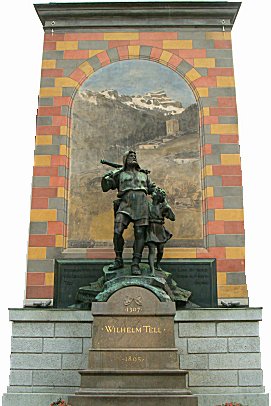
built by Richard Kissling (1895)
Tell's Chapel near Sisikon
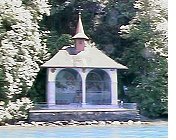 Local tradition says that a first chapel had been constructed in 1388
at the place where William Tell is said to have escaped from
boat of the bailiff Gessler. The oldest documents mentioning
a chapel there date back to 1516/1530, however.
Local tradition says that a first chapel had been constructed in 1388
at the place where William Tell is said to have escaped from
boat of the bailiff Gessler. The oldest documents mentioning
a chapel there date back to 1516/1530, however.
Tell's chapel became a place of pilgrimage from the 16th century on. The current chapel was constructed in 1879.
Four frescos by Ernst Stückelberger of Basle show the scenes of the legend:
- The bailiff Gessler forces William Tell to shoot an apple off his son's head with his crossbow.
- William Tell escapes from the boat of the bailiff Gessler during a storm on Lake Lucerne.
- William Tell shooting the tyrant Gessler.
- The oath of the Swiss confederates on the Rütli.
How to find Tell's Chapel: GPS coordinates lat=46.932719 lon=8.611801
Map by search.ch
The legend of William Tell in pictures
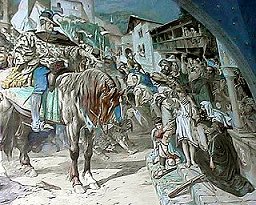 The bailiff Gessler representing the count of Habsburg in central Switzerland requests that everybody greets his hat on a rod in Altdorf (Uri). William Tell refuses reverence to the hat. The bailiff forces William Tell to shoot an apple off his sons head with his crossbow. William Tell hits the apple, but he has prepared a second arrow to shoot the bailiff in case he would have hurt the child. |
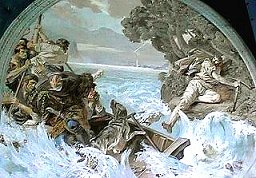 William Tell is arrested and put in chains. The bailiff leaves with a boat on Lake Lucerne heading for his castle at Küssnacht. A storm due to warm fallwinds (not unusual in the region) brings the bailiff's team into distress. They let William Tell, who is more familiar with the lake, control the boat. William Tell directs the boat towards a small flat rock, takes his crossbow and jumps off while pushing the boat back into the waves. |
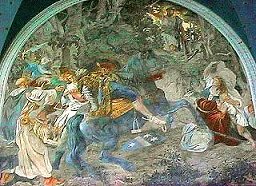 William Tell shoots tyrant Gessler in the hollow way between Immensee and Küssnacht. |
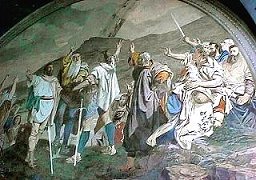 The oath of the Swiss confederates on the Rütli |
The tradition dates the heroic action of William Tell and the oath of the Swiss confederates against the counts of Habsburg on the Rütli back to 1307 (see above, date on monument). But one cannot find any document concerning a person named Wilhelm Tell nor the assassination of a bailiff in central Switzerland. Only in 1470, more than a century after the alledged events, a chronicle named the "White Book of Sarnen" reports the legend for the first time. A few years later, William Tell takes a prominent role in a ballad singing the praises of the beginnings of the Swiss Confederation. One generation later, a drama (Urner Tellspiel) is played in Central Switzerland. Centuries later, William Tell is mentioned in the standard history book Chronicon Helveticum (1734) by Aegidius Tschudi. In the 19th and 20th centuries the legend was severely questioned by historians.
William Tell and the Revolution
William Tell was very popular during the French Revolution (1789) and he became the official symbol on the seal of the revolutionary Helvetic Republic of Switzerland (1798 - 1803). Even the revolutionary Russians of the 19th century and the Spanish republicans of the 20th century referred to William Tell.
The drama "Wilhelm Tell" by Friedrich von Schiller
The classical drama Wilhelm Tell by the well-known German poet
Friedrich von Schiller, put on the stage for the first time in
1804 at Weimar (home of Goethe and Schiller), is doubtless the most
elaborate and at the same time most popular version of the legend of
William Tell. Schiller's drama is put on stage every year in Interlaken
(www.tellspiele.ch) and even in New Glarus, Wisconsin, U.S.A.
(www.wilhelmtell.org).
Friedrich von Schiller was always very interested in the subject of
liberty. His drama played an important role for the German moral in
the wars against Napoleon.
 Friedrich Schiller: Drama Wilhelm Tell, key phrases and interpretation (in German).
Friedrich Schiller: Drama Wilhelm Tell, key phrases and interpretation (in German).
William Tell during the second World War
Before and during the second World War, William Tell became an important symbol of the Swiss will to withstand the Nazis and to defend Switzerland's autonomy against Hitler's ideas of "Großdeutschland" (Great Germany uniting all German speaking regions in one empire). The reactivation of the Swiss tradition of liberation was part of the phenomenon called Spiritual National Defense. Several films showed scenes from the legends in a naive manner as if there had never been any critical historian in the 19th century.
The crossbow as label for Swiss quality products
 The usage of William Tell's crossbow as a label for
Swiss quality products was also born in these times of crisis.
In the 1970's, when the Spiritual Defense, extended during the
cold war, was definitely abandonded, the crossbow-label
also disappeared quietly.
The usage of William Tell's crossbow as a label for
Swiss quality products was also born in these times of crisis.
In the 1970's, when the Spiritual Defense, extended during the
cold war, was definitely abandonded, the crossbow-label
also disappeared quietly.
The central question:
How to win liberty?
William Tell represents the Swiss confederates, he thinks that it is justifiable to kill a tyrant, when the despot in his arbitrariness demands for inhuman acts. Liberty is seen as the absence of tyranny and of oppression. But this is only the first half of the solution of of the problem of liberty: It is well known, that the liberation movement of the French Revolution (any many others since) was drowned in the chaos of anarchy and terror - because the second half of our question was not thoroughly thought of.
The other half of the problem of liberty consists exactly in the necessity to create a stable order that gives rights and equal opportunities to all. Therefore, real liberty can be realized - even if this may appear a paradox - only, if one accepts limits to individual liberty: My liberty must be limited where it collides with the liberty of others.
When Friedrich Schiller and today's conservative supporters of a liberty represented by William Tell see only the so-called hereditary rights of the old Swiss confederates against the counts and bailiffs and the right to resistance against tyranny, they sacrifice true liberty.
True liberty can be won only together with its sisters, equality and solidarity. If one tries to separate liberty from the other two, liberty will be lost A stable and just balance that gives real oppotunities to those being less strong, is the key element of a modern, liberal and democratic state. In a constitutional state, nobody is authorized to get himself justice with a weapon in his hands like William Tell. Everybody must subordinate themselves to the decisions taken by democratic authorities. Only thus liberty and security can be guaranteed for all.
The mass assassination in the cantonal parliament of Zug (central Switzerland) on September, 27th 2001, killing dozens of members of parliament and government was committed by a man that felt himself being treated unfairly by the authorities. "Who still doubts, whether our country needs stricter laws on weapons, is advised to read the final report of the investigation commission of Zug on the attempt of September, 27th 2001.
(Newspaper editorial by Werner Steinmann, Waffen nicht in falsche Hände, in: Neue Luzerner Zeitung, 2003-10-24, p. 35, translation by M. Jud).Switzerland and the United States of America do have a similiar, but dangerous tradition of liberal access to weapons. And the rifle lobby is strong in both countries, preventing stricter laws on weapons and reducing thereby security for all.
Literature and links on William Tell:
- Jean François Bergier: Guillaume Tell.
Paris: Librairie Arthème Fayard, 1988
This book by the well known Swiss historian gives a broad description of the history of the Switzerland from the age of the romans to the the birth of the old Swiss confederacy and situates the legend of William Tell in the historic context. - Museum of William Tell in Bürglen (Uri, Central Switzerland), where Tell lived according to the legend.